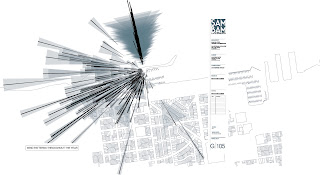The Golden Gate Yacht Club is the holder and host for the 2012 Americas Cup. The new GGYC club-house, therefore, is a building for sailors. As such, wind becomes the primary driver for the formal moves in the building.
Extremely high resolution wind data was collected - measurements from every five minutes for the last year was averaged out. Detailed wind analysis revealed two prevailing seasonal wind directions NNW and SW. We devised our own taxonomy to represent the varying wind directions found on the site. To exploit this, we kinked the building in the middle to expose it to each direction.
Large funneled cut outs in the building accelerate wind through the circulation zones using the Venturi effect. The basic way that you interact with the building is through the thrill of exposure to the wind – truly a sailors dream. Indeed, the main entrance takes you through the largest and most extreme wind condition.
The leeward side of the building receives an applied façade that registers the wind traveling through the funnels by opening and closing. Always moving, this façade is activated by paddles embedded in the façade. It changes the porosity of the building skin and becomes a visual reminder of the building parti. The way the building looks is contingent on its environmental factors.
We went for a more diagrammatic model that showed the funnels and kinetic facade. A solid piece of white ash was CNC milled in several passes to get the most precise resolution. The model was split in half and cut from each side because the draft angles and depth prevented a single cut.
We also made a 1:1 prototype of the kinetic facade to give an impression of the scale of the thing in relation to the human body. Cost prevented us from making it operable, much as we wold have loved to...who would have thought that linear bearings could be so expensive.











